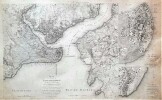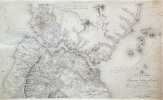[DIDOT L'AINE] -
MELLING
VOYAGE PITTORESQUE DE CONSTANTINOPLE ET DES RIVES DU BOSPHORE D’APRÈS LES DESSINS DE M. MELLING ARCHITECTE DE L'EMPEREUR SELIM III, ET DESSINATEUR DE LA SULTANE HADIDGE SA SŒUR.
PUBLIÉ PAR MM. TREUTTEL ET WÜRTZ. PARIS (DIDOT L'AINÉ) TEXTE: non relié , format 73 x 56 cm , 142 pp comprenant 1 Faux-titre , Frontispice Selim III , Titre avec caractère arabe doré , préface des éditeurs (10pp ) et 128 pages non chiffrées de description des planches , quelques feuilles brunies , la dernière feuille (liste des planches)présentant un manque de papier sans affecter le texte , quelques réparations aux bords
Reference : PHO-246
Le chef-d'œuvre d'Antoine Ignace Melling, Voyage pittoresque de Constantinople et des rives du Bosphore, nous livre nos illustrations inspirantes de la semaine. Melling, né dans le sud de l'Allemagne d'un père artiste, élevé par un oncle peintre . Dans les années 1780, il avait rejoint la suite de l'ambassadeur de Russie et voyagé en Italie,en Égypte et à Constantinople.La vie de ce jeune artiste aventurier allait changer quand il a été présenté à Hatrice Sultan, sœur du Sultan ottoman Selim III . Impressionnée par son art et son sens du détail architectural, Hatrice Sultan a nommé Melling architecte impérial, poste qu'il a occupé pendant 18 ans.Pendant son séjour à Constantinople, Melling a conçu des jardins, des palais, des vêtements et des bijoux pour Hatrice Sultan. Il a également eu l’occasion de réaliser des dessins détaillés de l’intérieur des palais du sultan, d’observer la société ottomane et de dessiner Constantinople et ses environs. Melling est revenu à Paris en 1803 et a publié un prospectus pour les abonnés de ce qui serait son Voyage pittoresque de Constantinople et des rives du Bosphore.Après six ans, il avait collecté suffisamment d'argent et créé un atelier de gravure pour commencer la production de son travail. En 1809, Melling avait obtenu la description textuelle de ses plaques de Charles de Lacretelle et le premier des 12 numéros était publié, chacun avec quatre plaques. En 1819, les 12 numéros, une description topographique (par Jean-Denis Barbié du Bocage) et trois cartes gravées avaient été publiés. Cette superbe collection de gravures offre certaines des premières vues intérieures des palais du sultan ainsi qu'un portrait très intime de la société ottomane. MELLING (ANTOINE IGNACE) VOYAGE PITTORESQUE DE CONSTANTINOPLE ET DES RIVES DU BOSPHORE D’APRÈS LES DESSINS DE M. MELLING ARCHITECTE DE L'EMPEREUR SELIM III, ET DESSINATEUR DE LA SULTANE HADIDGE SA SŒUR. PUBLIE PAR MM. TREUTTEL ET WÜRTZ. PARIS (DIDOT L'AINE) PARIS: 1819. TEXT: unbound, format 73 x 56 cm, 142 pp including 1 Half-title, Frontispiece Selim III, Title with golden Arabic character, preface of the editors (10pp) and 128 unnumbered pages of description of the plates, some burnished sheets, the last sheet (list of boards) showing a lack of paper without affecting the text, some repairs to the edges. A picturesque voyage of Constantinople and the banks of the Bosphorus, gives us our inspiring illustrations for the week. Melling, born in the south of Germany to an artist father, raised by a painter uncle. In the 1780s he had joined the Russian ambassador's suite and traveled to Italy, Egypt and Constantinople. The life of this young adventurer artist was about to change when he was introduced to Hatrice Sultan, sister of the Ottoman Sultan Selim III. Impressed by his art and his sense of architectural detail, Hatrice Sultan appointed Melling imperial architect, a position he held for 18 years. During his stay in Constantinople, Melling designed gardens, palaces, clothing and jewelry for Hatrice Sultan. He also had the opportunity to realize detailed drawings of the interior of the Sultan’s palaces, observing Ottoman society and drawing Constantinople and its surroundings. Melling returned to Paris in 1803 and published a prospectus for subscribers of what would be his scenic voyage from Constantinople and the banks of the Bosphorus. After six years, he had collected enough money and created an engraving workshop to start producing his work. In 1809 Melling had obtained the text description of his Charles de Lacretelle plaques and the first of 12 issues was published, each with four plaques. In 1819, the 12 numbers, a topographic description (by Jean-Denis Barbié du Bocage) and three engraved maps had been published. This superb collection of engravings offers some of the first interior views of the Sultan's palaces as well as a very intimate portrait of Ottoman society.
Bookseller's contact details
Librairie Voyage et Exploration
M. Stéphan Feldman
09 86 72 59 94
Payment mode

Sale conditions
Les colis sont soignés, possibilité d'envoi partout dans le monde avec COLISSIMO international, frais à définir selon le poids de l'ouvrage et l'assurance choisie.
 Write to the booksellers
Write to the booksellers






